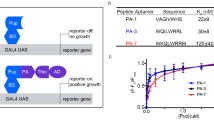Abstract
Interaction selection by biopanning from a fragmented yeast proteome displayed on filamentous phage particles was successful in identifying proline-rich fragments of Boi1p and Boi2p. These proteins bind to the second ``src homology region 3'' (SH3) domain of Bem1p, a protein of Saccharomyces cerevisiae involved in bud formation. Target Bem1p was a doubly-tagged recombinant, Bem1[Asn142-Ile551], which strongly interacts in ELISA with a C-terminal 75 amino acids polypeptide from Cdc24p exposed on phage. The whole yeast genomic display library contained ~7.7 × 107 independent clones of sheared S. cerevisiae genomic DNA fused to a truncated M13 gene III. This study corroborates the value of fragmented-proteome display to identify strong and direct interacting protein modules.
Similar content being viewed by others
References
Altschul SF, Madden TL, Schaffer AA, Zhang J, Zhang Z, Miller W, Lipman DJ (1997) Gapped BLAST and PSI-BLAST: a new generation of protein database search programs. Nucleic Acids Res 25:3389–3402
Bender L, Lo HS, Lee H, Kokojan V, Peterson V, Bender A (1996) Associations among PH and SH3 domain-containing proteins and Rho-type GTPases in Yeast. J Cell Biol 133:879–894
Breikreutz BJ, Stark C, Tyers M (2003) The GRID: the general repository for interaction datasets. Genome Biol 4:R23
Butty AC, Pryciak PM, Huang LS, Herskowitz I, Peter M (1998) The role of Far1p in linking the heterotrimeric G protein to polarity establishment proteins during yeast mating. Science 282:1511–1516
Chant J (1999) Cell polarity in yeast. Annu Rev Cell Dev Biol 15:365–391
Drees BL, Sundin B, Brazeau E, Caviston JP, Chen GC, Guo W, Kozminski KG, Lau MW, Moskow JJ, Tong A, Schenkman LR, McKenzie A 3rd, Brennwald P, Longtine M, Bi E, Chan C, Novick P, Boone C, Pringle JR, Davis TN, Fields S, Drubin D (2001) A protein interaction map for cell polarity development. J Cell Biol 154:549–571
Dumont D, Noben J-P, Raus J, Stinissen P, Robben J (2004) Proteomic analysis of cerebrospinal fluid from␣multiple sclerosis patients. Proteomics 4:2117–2124
Fazi B, Cope MJ, Douangamath A, Ferracuti S, Schirwitz K, Zucconi A, Drubin DG, Wilmanns M, Cesareni G, Castagnoli L (2002) Unusual binding properties of the SH3 domain of the yeast actin-binding protein Abp1: structural and functional analysis. J Biol Chem 277:5290–5298
Fields S, Song O (1989) A novel genetic system to detect protein–protein interactions. Nature 340:245–246
Hertveldt K, Dechassa ML, Robben J, Volckaert G (2003) Identification of Gal80p-interacting proteins by Saccharomyces cerevisiae whole genome phage display. Gene 307:141–149
Ito T, Matsui Y, Ago T, Ota K, Sumimoto H (2001) Novel modular domain PB1 recognizes PC motif to mediate functional protein–protein interactions. EMBO J 20:3938–3946
Jacobsson K, Frykberg L (1995) Cloning of ligand-binding domains of bacterial receptors by phage display. Biotechniques 18:878–885
Lindmark H, Guss B (1999) SFS, a novel fibronectin-binding protein from Streptococcus equi, inhibits the␣binding between fibronectin and collagen. Infect Immun 67:2383–2388
Matsui Y, Matsui R, Akada R, Toh-e A (1996) Yeast src homology region 3 domain-binding proteins involved in bud formation. J Cell Biol 133:865–878
Park HO, Bi E, Pringle JR, Herskowitz I (1997) Two active states of the Ras-related Bud1/Rsr1 protein bind to different effectors to determine yeast cell polarity. Proc Natl Acad Sci USA 94:4463–4468
Parmley SF, Smith GP (1988) Antibody-selectable filamentous fd phage vectors: affinity purification of target genes. Gene 173:305–318
Rickles RJ, Botfield MC, Zhou XM, Henry PA, Brugge JS, Zoller MJ (1995) Phage display selection of ligand residues important for Src homology 3 domain binding specificity. Proc Natl Acad Sci USA 92:10909–10913
Acknowledgements
K. Hertveldt holds a postdoctoral position of the ``Fonds voor Wetenschappelijk Onderzoek'' (FWO)-Vlaanderen. This work was financially supported by FWO grants G017297N and G0114-01, EU contract BIO4-CT97-2294B4 and the Research Council of the K.U.Leuven (OT/98/20 en OT/04/30).
Author information
Authors and Affiliations
Corresponding author
Rights and permissions
About this article
Cite this article
Hertveldt, K., Robben, J. & Volckaert, G. Whole Genome Phage Display Selects for Proline-rich Boi Polypeptides against Bem1p. Biotechnol Lett 28, 1233–1239 (2006). https://doi.org/10.1007/s10529-006-9082-y
Received:
Accepted:
Published:
Issue Date:
DOI: https://doi.org/10.1007/s10529-006-9082-y




